I know you love nature but I wonder what kind of nature-lover you are. The biologist E O Wilson identified two types. I fall into the first: the ‘big organism’ tribe. We are always on the lookout for large exciting things – mammals, birds, butterflies, flowers – with our gaze flicking from ground level to tree-top as we walk, our ears twitching to cheeps, hoots and slithers.
Wilson places himself in the second group: a hunter still, but of small things – ‘more a snuffling possum than a questing panther’ to use his words. Nature-lovers of this kind rarely get a few hundred metres from the carpark, so busy are they turning over logs and poking around in the leaf mould. And once they have had their fill of spiders and centipedes, a hand lens reveals tiny mites and worms in a labyrinthine world of fungal threads.
So I decided to try it for myself. Instead of dashing around the fynbos looking for snakes and rare plants, I’d slow down and focus on the smaller stuff, the details. And here’s what I saw.
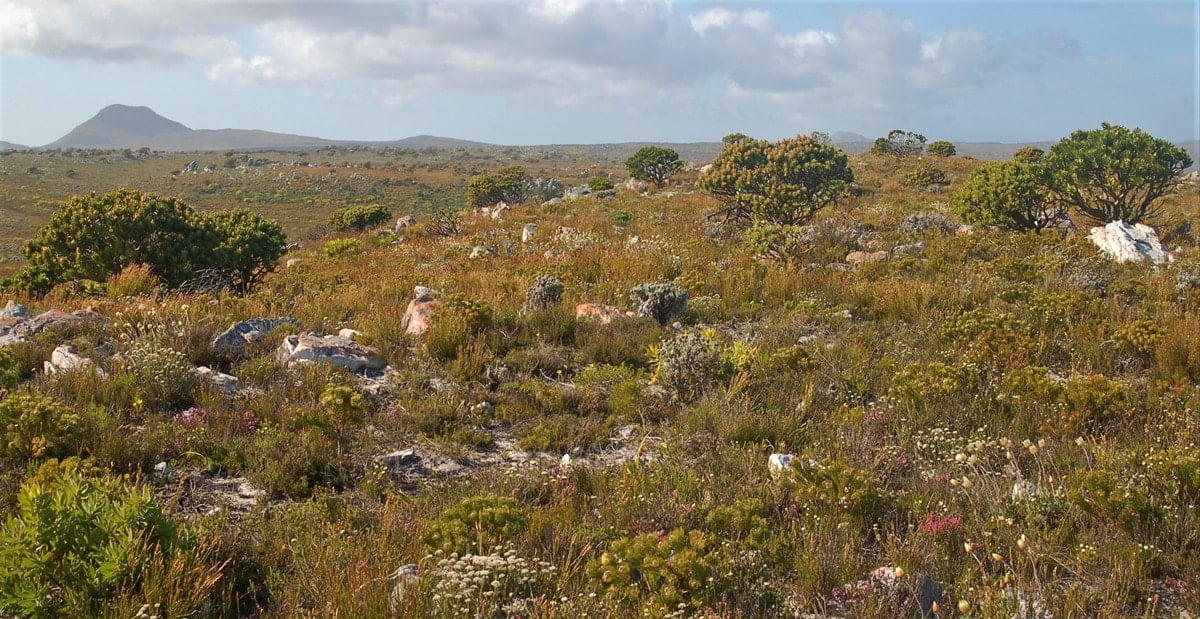
Take the above scene in the Cape of Good Hope Reserve. It’s a typical fynbos landscape: rocky, bushy, and – in terms of what is growing – seemingly random. There are large, tree-like bushes, tufts of reeds and a thick blanket of bushes at knee-height. But look a little closer and you’ll see that there is method in this apparent madness: the different sizes of the plants reflect not just the age of the fynbos (in the sense of when the last fire was) but also how fynbos plants respond to fire.
The big tree-ish plants are two different kinds of protea: a Pagoda Protea (Mimetes) and a Pincushion (Leucospermum). They are known as ‘re-sprouters’, surviving fires thanks to their thick corky bark and deeply embedded growing buds. The bigger, older individuals have survived several fires over the decades but there are younger ones too, making a mix of both large and small plants.
The carpet of greenery at the same height, on the other hand, indicates ‘re-seeders’ – plants from many different families that disperse their seeds before the flames or scatter them shortly after. The parent plants generally don’t survive fire and so there is a fairly similar size to the next generation, all inching up together over the years. It’s especially noticeable when you encounter stands of the same re-seeding species.
And to measure, or at least estimate, the age of the veld, then not only is the size of the plants a useful guide (proteas produce a flower once a year and thus can be aged by counting the old flowers from branch tip to stem) but their diversity is key too.
The fynbos above burnt in 2015 and so was six years old when the photograph was taken: the fast-growing, post-fire colonisers – daisies, peas and pelargoniums – are finally giving way to the slower growing ericas (heathers) and proteas and the result is an extravagance of diversity. Without a choking canopy of large plants, every species is now able to enjoy its time in the sun and you’ll never see a greater mix of different species in fynbos than in the six to eight years after a fire. Return to this scene in ten or twelve years’ time (assuming there is no intervening fire) and those tall re-sprouting proteas will be sticking out of a much denser cover of other proteas (the re-seeding Leucadendrons for example) and there will be far less floral diversity.
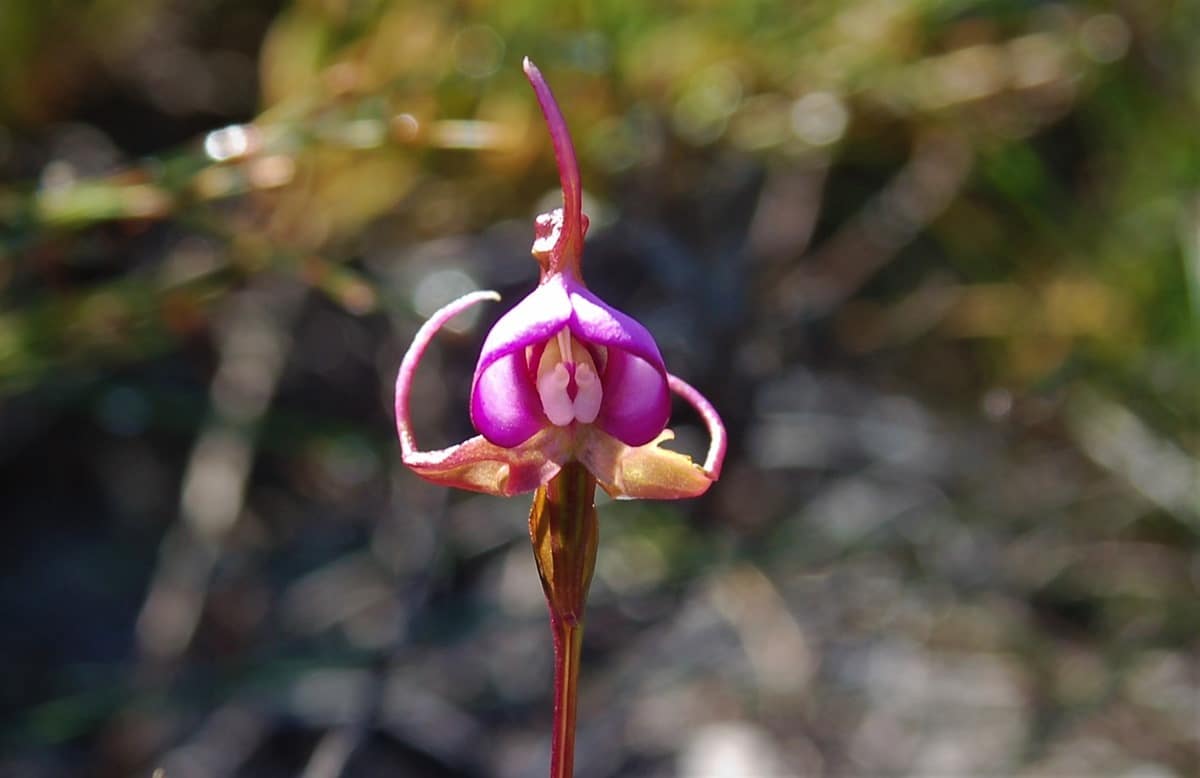
Ooooo! What’s this … an orchid! But you see, I have lapsed back into the ways of my tribe again, seeking the thrill of a big find: click and move on. So let’s have another look at Disperis capensis, the Granny Bonnet Orchid and its extraordinary flower. Compared to the child-like simplicity of a daisy flower, it’s no wonder orchids are referred to as ‘advanced plants’ but something bothered me: why put on such a big show? Why pink and white? And what’s with the crazy shape?
The answer lay a few yards away.

Disperis capensis is a mimic, like many other orchids in the Cape, and it is attempting – successfully I suppose – to impersonate the Polygala flower above. The sneaky orchid has no nectar to offer but the polygala does and bees just love them. What the orchid hopes for is to be mistaken for a polygala and visited by busy bees, which only realise they’ve been duped after they have inadvertently effected pollination. It’s a high-risk strategy: there’s no need to waste resources on producing nectar but you’ve got to make sure that the disguise is a good one. Some Cape orchids mimic female wasps while others look and smell like rotting meat. And one, Disa ferruginea, subtly changes its disguise as the species it mimics change within the orchid’s range.
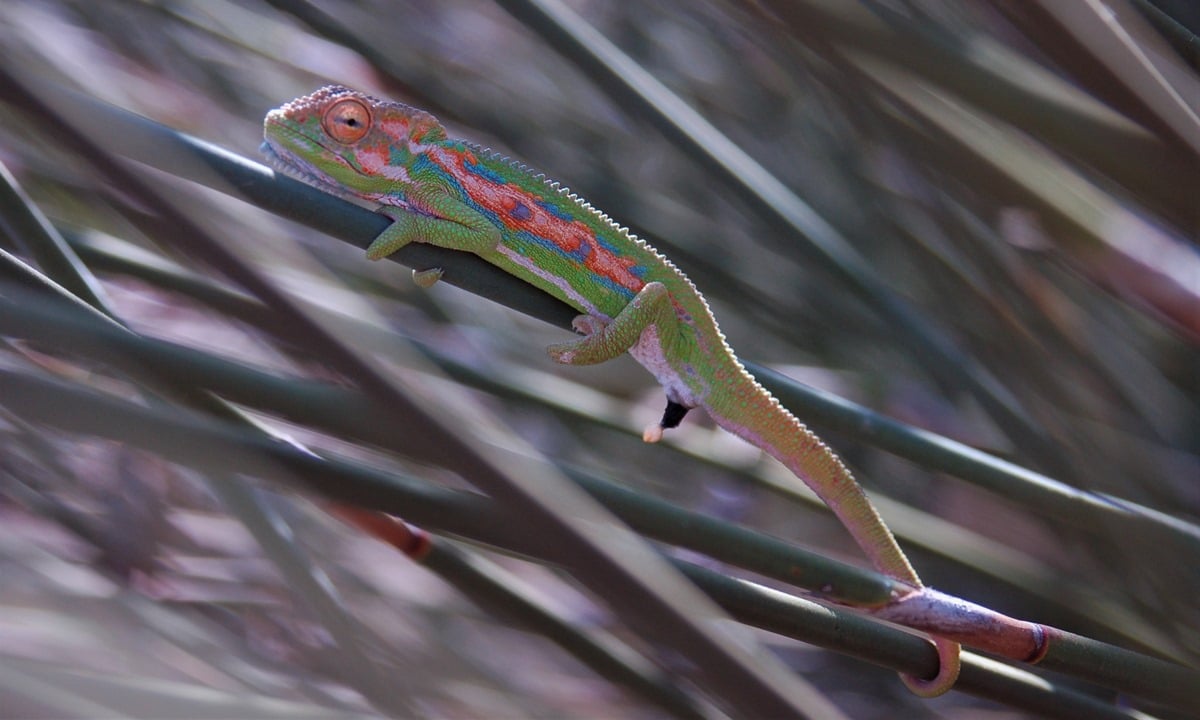
Okay, even E O Wilson will come running over for this one. A Cape Dwarf Chameleon (Bradypodion pumilum) – once common but a rare find these days. I usually see them in clumps of restios, the Cape Reeds that predominate – indeed, define – fynbos environments. Tough, impenetrable thickets of restios provide chameleons with effective protection from predatory birds, snakes and mammals but their wiry stems and tiny flowers don’t attract many insects to prey on, which is why there’s another dwarf chameleon over here.
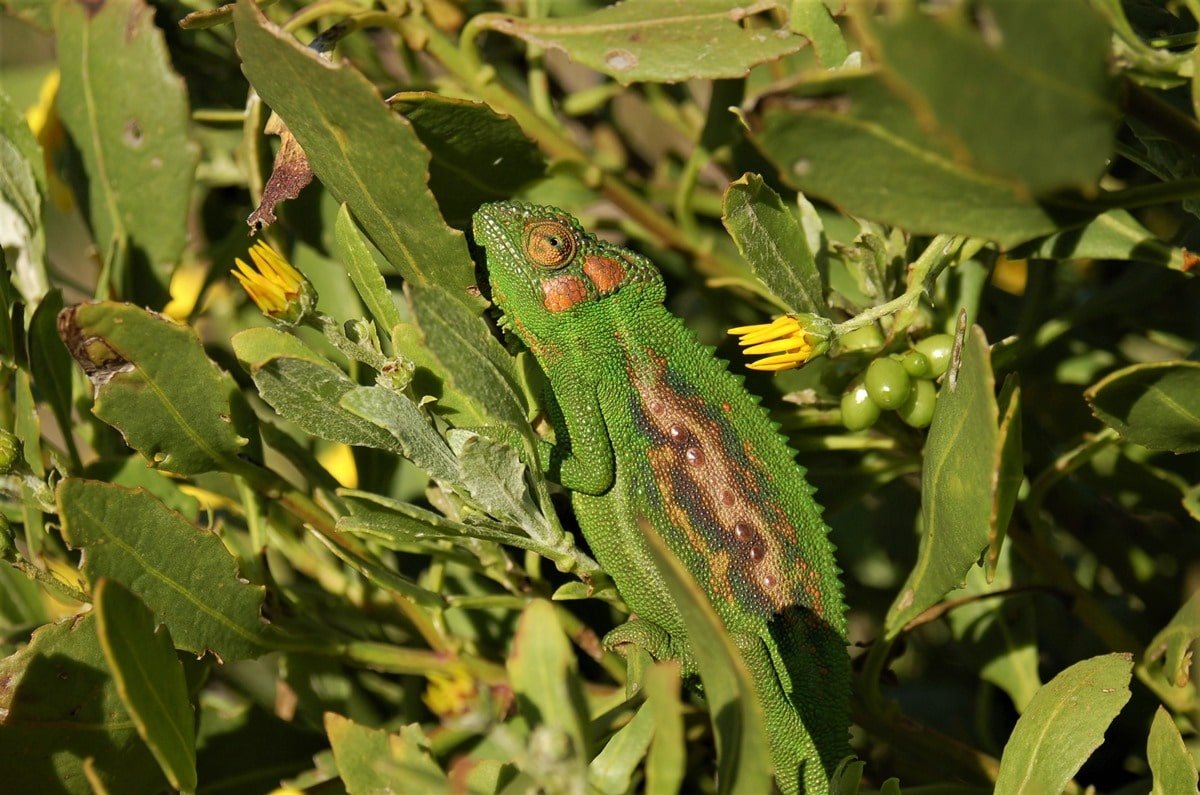
This one is in a Bitou bush (Chrysanthemoides monilifera) and for good reason: Bitou is a prolific producer of yellow flowers (it’s a daisy) and there were so many insects humming and buzzing over this bush it sounded like static electricity: perfect hunting ground for our swivel-eyed friend. I turned the camera on, ready for the big shot – Fly! Tongue! Kersplat! – before remembering my mission and settling down for a closer look.
Obviously the chameleon is a master of colour camouflage but it looks like it has taken the strategy a step further: is it just me or does the shape of the chameleon – its body form – actually resemble that of the Bitou leaf? You can even see the ‘teeth’ of the leaves reflected in the spines along the chameleon’s back – its dorsal ridge. It would make sense: Bitou is abundant in the Dwarf Chameleon’s habitat and it flowers for weeks at a time in the Cape’s cold winter months, attracting insects when food is otherwise hard to find. It reminded me that other animals are also realigning their body for life in fynbos: the Cape Grass Lizard (Chamaesaura anguina), for example, finds it easier to ‘swim’ through the tangled twigs of fynbos rather than trying to run through them and the species is in the evolutionary process of losing its legs (only feeble little remnant limbs remain) just as snakes did tens of millions of years ago.
Shape and form were themes running through my mind as I came off the fynbos and started walking down to the beach in the Cape of Good Hope Reserve. A sudden sharp stab to my leg made me yelp in alarm but the culprit was no venomous serpent but its floral equivalent – Snake Thistle (Cullumia squarrosa).

Many fynbos plants are prickly. Not thorny, like plants in Africa’s savannahs, but prickly: their leaves end in a sharp, stiff spine. This is reflected in the common names of several plants – Cape Gorse, Hiker’s Horror, Steekbos, Steekhaarbos and of course Snake Thistle – but if spiny leaves are meant to protect the plant from herbivorous predation – as a thorn tree or rose bush does – then why was this happening?
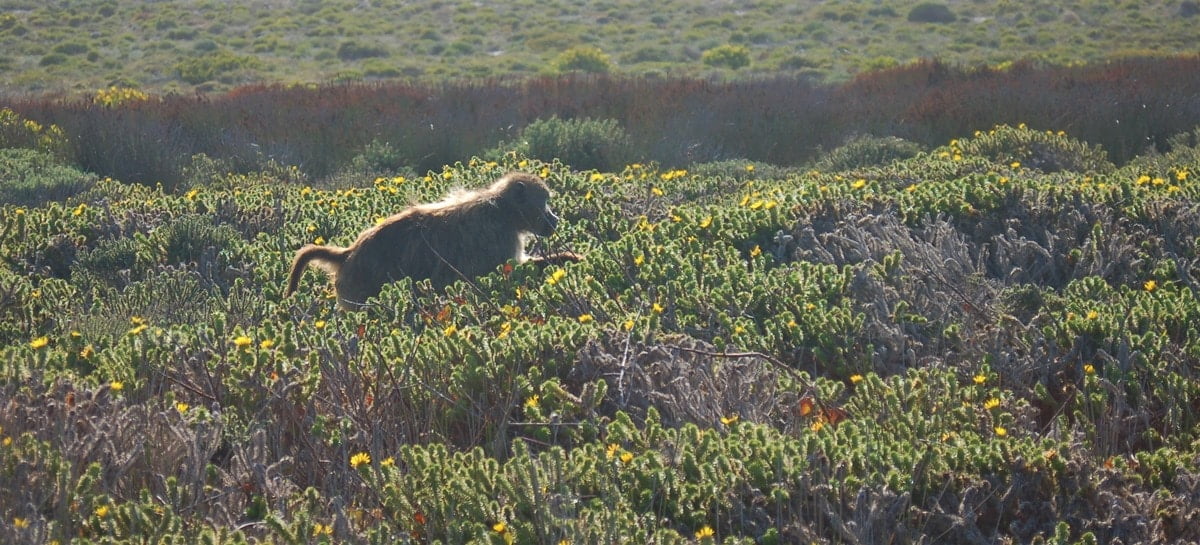
A baboon troop was foraging in the coastal fynbos and they romped over the prickly clumps of Snake Thistle like they were down-filled pillows. The baboons were after the flowers (in the interests of science I tried one and it was horrible) and they didn’t seem deterred by the spines at all. So what’s the point of them? Well, while it is true that some fynbos plants – notably post-fire colonising pea species – do have nutritious leaves that are aggressively sharp, it also pays to remember the golden design rule of all fynbos plants. And that is to reduce water loss.
Fynbos plants do this in a variety of ways: they may save water in fat, succulent leaves or minimise its loss via tiny, waxy leaves. Some plants cover their leaves in protective grey hair while others have lost their leaves entirely and photosynthesise through their green stems. And the spine-tipped leaf of the Snake Thistle is part of this: by channelling excess heat through the leaf and into the tip, the plant loses heat to the atmosphere and thus saves water – is it a step too far if it is likened to ‘sweating’?
By now I was on the cold sand of an Atlantic beach, looking at fresh otter tracks and wondering whether I should try and find them. Or maybe I should just slow down, turn over some rotting seaweed and see what happens. But that’s for another time.
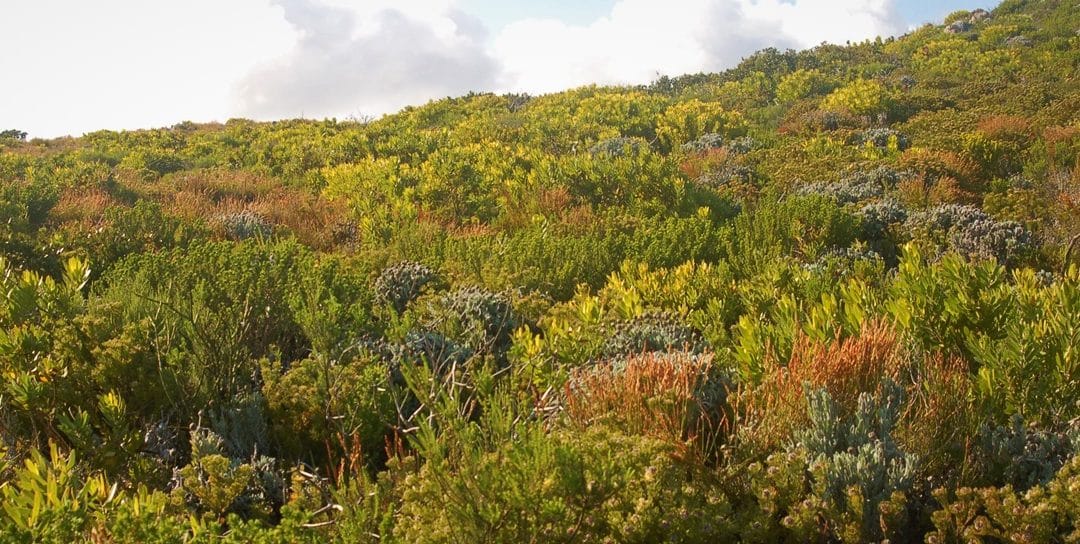
Great blog. Thanks for encouragement to take a closer look at smaller members of the ecosystem and their special habitat requirements.
Very rewarding.
Thank you Malva – the fynbos is often so distractingly beautiful that we forget about the intricacies therein!
Dominic, your first photo of the Cape of Good Hope Reserve is like a treasure chest to me. I’m just salivating wondering who all live there… bugs – creeping or flying in from elsewhere, lizards, maybe a frog or a tortoise …
I live in a duplex (and therefore am starved for nature’s wonders), so I’ve learnt to study sidewalks out of pure boredom. At the beginning I wasn’t pleased with the weeds growing in the concrete cracks or on a tiny piece of soil beside a road, but then I saw the micro ecosystem has all kinds of wonderful surprises sometimes e.g. beetles feeding on the weeds, a visiting bee on a dandelion flower, ants. Fascinating to see how ants use their antennae. We are so used to ants we tend to ignore them.
Or maybe an earwig, bravely guarding her little nest in a damp spot underneath a rock or leaves. My insect field guide taught me that although earwigs are formidable hunters, fortunately they are harmless to people. Even though their forceps-tails may scare nosy humans.
I even developed admiration for the tenacity of weeds and look at them in a different way, trying to figure out their survival techniques. It was an eye opener and became an adventure.
I have just discovered you, Dominic and what a treasure you are to find! I love walking through and discovering our precious Fynbos, but hate walking with a book to identify species, as it’s slow enough when every few steps presents another glorious discovery. A friend and I have been know to take 30 minutes to walk 500m! I am now an avid reader of your blog.
Thank you.
And thank you Tracey-Leigh – and if you take 30 mins to get 500 metres when walking, then it seems you and E O Wilson are of the same tribe!